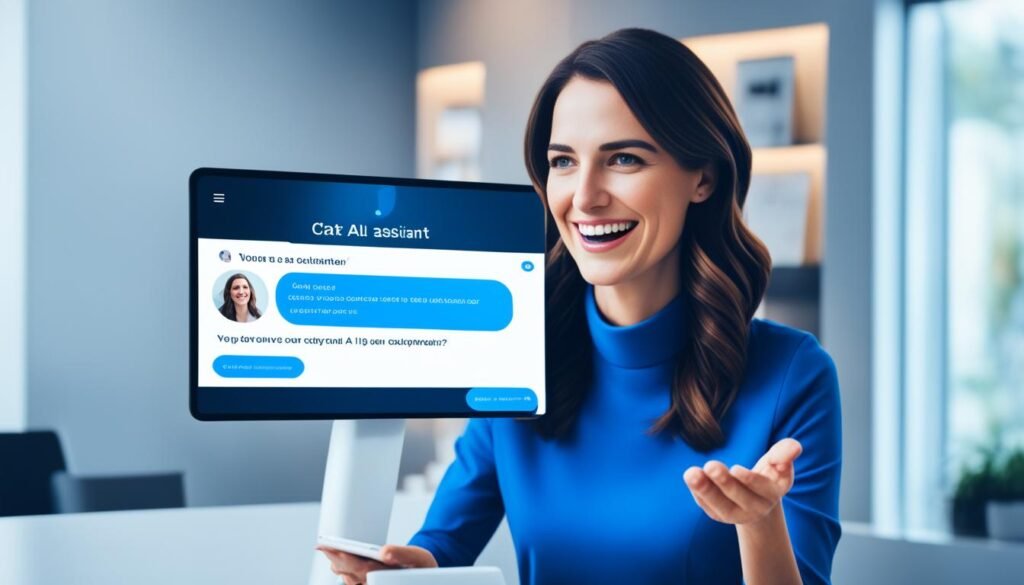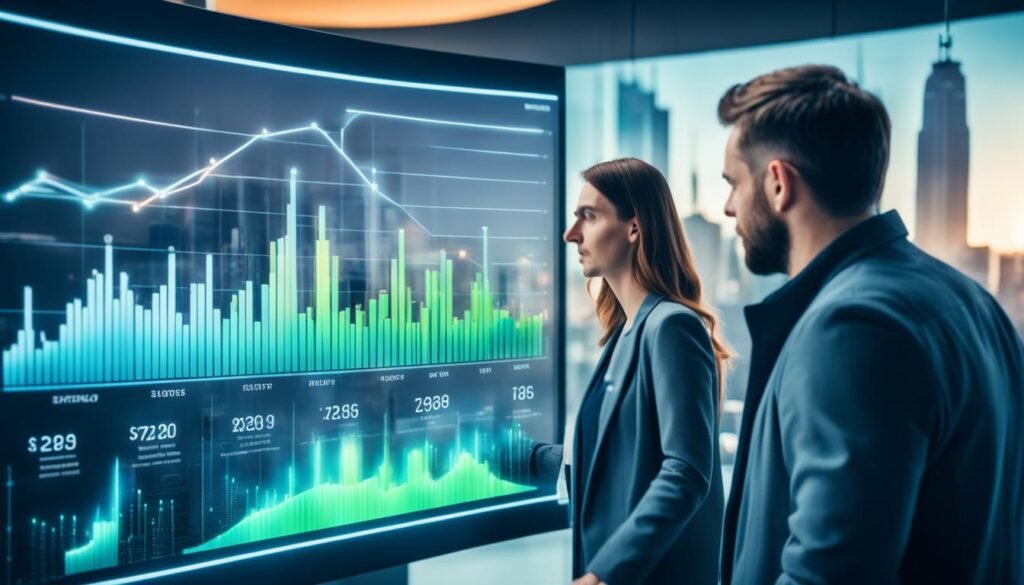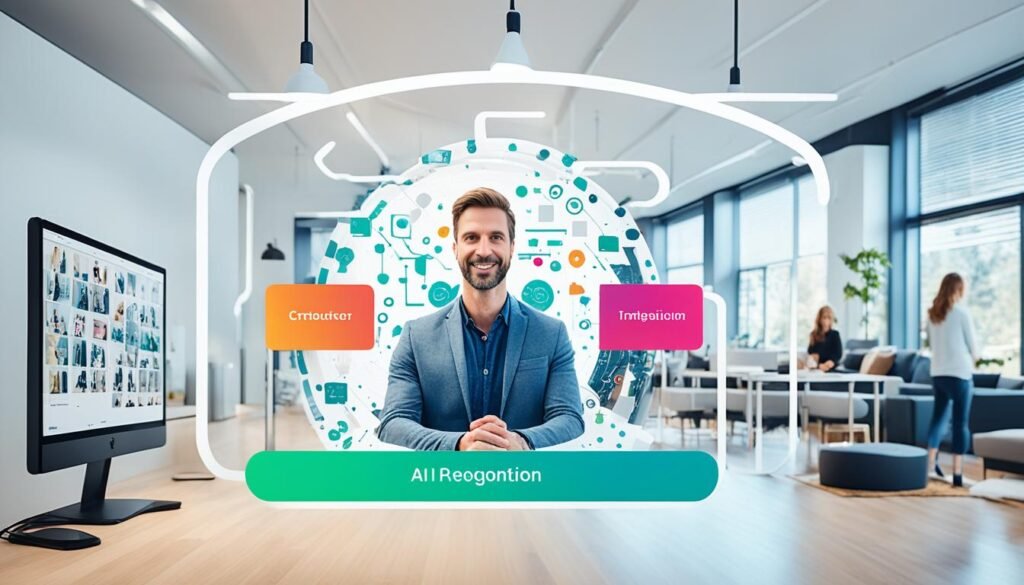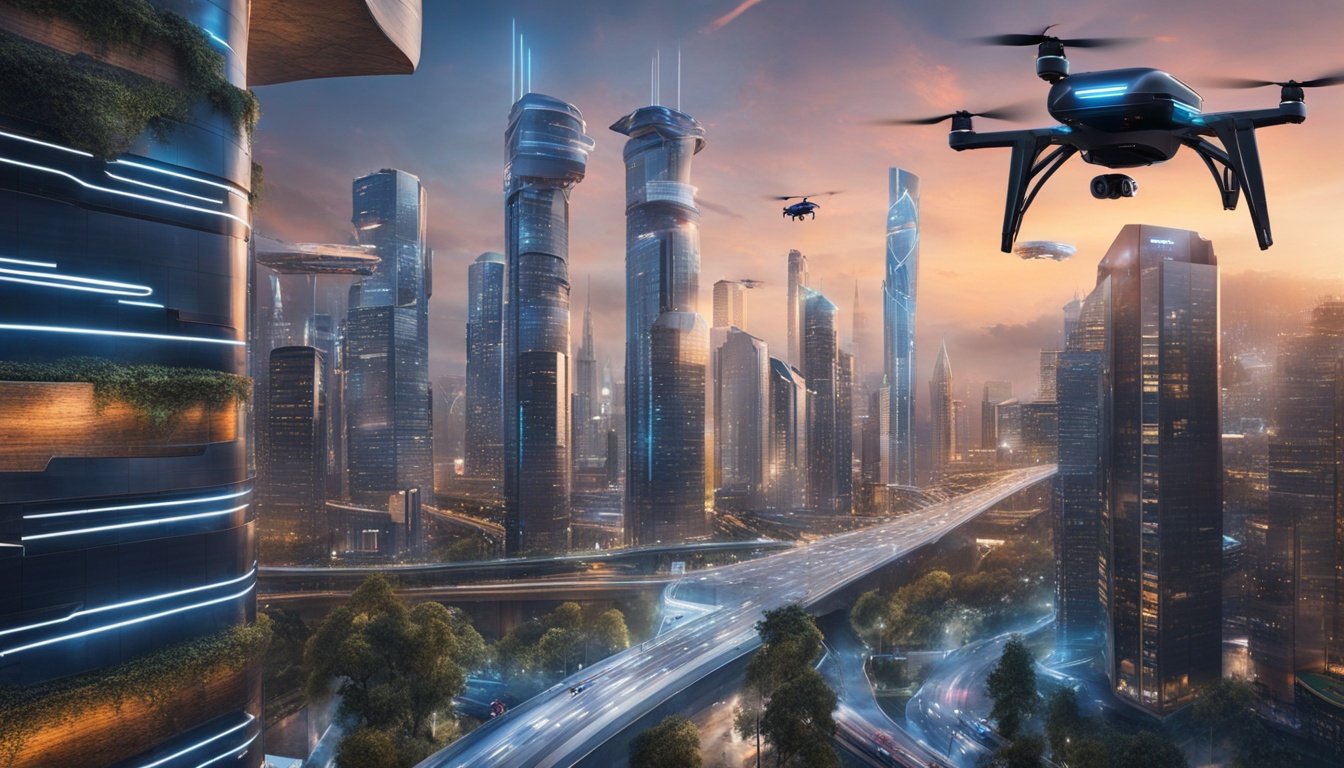In today’s fast-paced world, Artificial Intelligence (AI) is a game-changer. A whopping 41.8% of companies see image and video recognition as the top problem AI can fix. This shows how big an impact AI has.
AI is not just a future idea; it’s changing businesses in many fields. These include healthcare, e-commerce, automotive, education, and manufacturing. AI can look at huge amounts of data, making things more efficient and solving problems we couldn’t solve before.
AI is expected to make big strides in the next decade, making the world better. It has already helped businesses make huge profits and changed how we tackle challenges. AI has led to big advances in healthcare and cybersecurity, showing its wide impact.
Key Takeaways
- AI can solve many problems, like recognizing images and videos, helping with customer support, and preventing fraud.
- AI is changing many industries, such as healthcare, e-commerce, and manufacturing, by making things more efficient and solving problems better.
- Using AI in robotics can create smart systems that can do complex tasks.
- It’s important to develop AI ethically to make sure it’s used right and is open about its actions.
- It’s key to pick the right AI development company if you want to use AI well in your business.
Introduction
An AI solution is when we make advanced systems or software that can do tasks that need human smarts, like learning, solving problems, and understanding language. These AI-powered apps are changing how we live and work in many fields.
AI solutions include many technologies like machine learning, natural language processing, and complex algorithms. These systems look at huge amounts of data and make smart choices. This leads to better efficiency and solving problems more effectively.
AI solutions can be many things, from chatbots that help with customer service to personalized content for each person’s interests, or predictive analytics tools that spot trends. The potential of AI solutions is huge, and they’re set to change many areas, from healthcare and finance to retail and more.
Benefits of AI Solutions
Using AI solutions brings many benefits, including:
- Improved efficiency and productivity by automating tasks and making decisions
- Better customer experiences with personalized services and smart interactions
- More accurate insights through data analysis and predictive models
- Cost savings by making operations more efficient and streamlined
- Competitive edge by using AI-powered applications and AI development services
The abilities of what is an AI solution are getting better all the time. The benefits of AI solutions are clear in many industries and uses. They’re changing how we solve problems and make decisions.
Customer Support and Engagement
In today’s fast world, companies that really get their customers do well. Artificial Intelligence (AI) is growing fast, giving businesses new ways to learn about their customers. This helps them improve their support and connect better with people.
AI makes customer support faster and always available, unlike old ways. Chatbots handle simple questions, and NLP looks at what customers say. This is changing how companies talk to their customers.
AI makes customer support better by understanding what customers want. Biometrics, voice and face recognition, predictive personalization, and intent prediction help companies know what customers need. This lets them solve problems before customers even ask.
Also, AI can save businesses money. Chatbots and automated workflows take care of many customer questions. This lets human agents work on harder tasks. It makes things more efficient and helps customers feel valued.
According to the Zendesk Customer Experience Trends Report 2024,
“more than two-thirds of CX organizations agree that AI can help build loyalty through warm and familiar human service interactions.”
By using AI, companies can offer fast and quality support. This makes sure customers get help when they need it.

The need for smooth, personal customer support is growing as we use more technology. By using AI, businesses can better engage with customers. This helps them succeed in a changing market.
Data Analysis and Decision-Making
In today’s world, AI for data analysis is changing the game. Every day, we generate over 2.5 quintillion bytes of data. Companies are now using AI to find important insights and make smart choices. A Forbes report shows that 97.2% of companies are investing in AI to boost their analytics.
AI for decision-making is key. It helps analyze data in real-time, which is crucial for finance, manufacturing, and supply chain. AI can quickly go through both structured and unstructured data. It finds patterns and trends to predict the future and make smart moves.
New Insights
With AI for new insights, companies can deeply analyze their data. They find hidden patterns, trends, and chances that are hard to see by hand. These insights give decision-makers valuable info and steps to take, leading to better choices.
Data Unification
Data unification with AI helps companies bring together customer data from different places. This gives a full picture of who their customers are. Knowing what customers like helps businesses offer personalized experiences, make customers happier, and keep them coming back.
Marketing Outcomes and Business Prediction
AI for marketing outcomes and business prediction is great for using resources well, cutting costs, and making the most of what you have. AI looks at patterns and changes to spot risks, find oddities, and keep up with rules.
Adding AI to data analysis and decision-making is changing how businesses work. It’s driving innovation and opening up new chances for growth in a fast-changing world.
“AI not only drives innovation and competitive advantage but also enables organizations to explore new possibilities and uncover insights that propel business growth.”
Demand Forecasting
In today’s fast-paced business world, demand forecasting is key to success. This method uses AI to predict what customers will want in the future by looking at past data. It helps companies plan better, use resources wisely, and make customers happier.
Using AI for demand forecasting brings big benefits. Gartner’s survey says 45% of companies use machine learning for this. McKinsey Digital found that AI can cut supply chain errors by 30 to 50%. This leads to fewer lost sales due to not having enough stock.
AI does more than just make things more efficient. It can lower transportation and warehousing costs by 5-10%. Supply chain administration expenses can drop by 25-40%. This means a big boost in value for manufacturing and supply chain planning, adding $1.2 trillion to $2 trillion.
AI tools bring five main benefits to demand forecasting:
- Data consolidation and organizing for quicker analysis
- Automated replenishment planning based on real-time data, ensuring accurate inventory levels
- Quick responses to demand fluctuations, aiding businesses in adapting to sudden changes
- Detection of outliers in sales data, ensuring appropriate demand planning
- Improved manpower planning and customer satisfaction through more accurate forecasting
As companies grow, AI-powered demand forecasting tools are crucial. They help in sustained growth. Proper forecasting can boost shareholder value by at least 15%. It’s a must-have strategy for today’s businesses.

“AI-enhanced forecasting can reduce errors in supply chain networks by 30 to 50%.” – McKinsey Digital
By using AI for demand forecasting, companies can achieve new levels of efficiency. They can plan better, use resources wisely, and make customers happier. This leads to sustainable growth and profits in a changing business world.
Fraud Prevention and Security
In today’s digital world, businesses face a big threat from fraud. AI for fraud prevention and cybersecurity is a key solution. AI uses advanced algorithms to check huge amounts of data fast. It spots patterns that show identity theft, ID document forgery, and payment fraud.
Identity Theft Detection
Identity theft is a big problem in retail, where hackers steal customer info for fraud. AI-powered identity theft detection looks at customer data and device info to find suspicious actions. It learns from past data to spot new fraud methods fast and accurately.
ID Document Forgery Prevention
More and more, ID document forgery is a threat, especially in finance and e-commerce. AI-based ID verification checks documents for real security features. This stops fake IDs and keeps businesses safe.
Payment Fraud Detection
Scams like CEO fraud, false invoices, and account takeovers can cost businesses a lot. AI-driven payment fraud detection quickly checks transaction data and customer habits. It stops fraud in its tracks, keeping businesses and customers safe.
Using AI for fraud prevention is key for businesses to beat fraud. AI uses machine learning to make fraud detection faster and more accurate. This helps protect businesses and their customers from fraud’s harm.
| Fraud Detection Capability | Impact on Businesses |
|---|---|
| Identity Theft Detection | Safeguards customer information, maintains trust, and prevents financial losses |
| ID Document Forgery Prevention | Mitigates risks of fraudulent transactions, enhances security, and protects brand reputation |
| Payment Fraud Detection | Minimizes financial losses, streamlines operations, and improves customer experience |
“AI-powered fraud detection can save businesses money by preventing fraud losses and cutting down the need for extensive manual review teams.”
Image and Video Recognition
Artificial intelligence (AI) has made image and video recognition key tools in many industries. These tools use advanced algorithms like machine learning and deep learning to find important information in pictures and videos.
Machine learning models can spot and sort objects, faces, and patterns with great precision. Deep learning, a more advanced method, uses artificial neural networks to find complex details in images and videos. This helps with real-time object spotting and face recognition.
AI-powered image and video recognition has many uses. In security, it watches over public areas, industrial sites, and secure places. It sends alerts when it sees someone who shouldn’t be there. In healthcare, it helps find tumors, interpret X-rays, and spot symptoms in MRI scans, making diagnoses better and treatments more effective.
Autonomous cars use computer vision to see the world around them. They build 3D maps and recognize road signs, pedestrians, and obstacles. In farming, these technologies boost productivity and cut costs by automating tasks like checking field conditions, spotting plant diseases, and predicting weather and crop yields.
The market for AI image recognition is booming. It’s expected to hit USD 4.44 billion by 2029, growing at a 11.76% annual rate, says Mordor Intelligence. This shows how important and widely these technologies are becoming.
At the core of this change are improvements in machine learning and deep learning algorithms, like Convolutional Neural Networks (CNNs). These are great at handling and understanding visual data. As more large, varied datasets become available, AI’s image and video recognition will get even better. This will open up more possibilities across industries.
| Industry | Application | Benefits |
|---|---|---|
| Security and Safety | Automated monitoring and alert systems | Improved surveillance, enhanced security, and reduced risk |
| Healthcare | Medical image analysis and symptom detection | Faster diagnosis, more accurate treatment, and better patient outcomes |
| Transportation | Autonomous vehicle navigation and obstacle detection | Improved safety, reduced accidents, and increased efficiency |
| Agriculture | Crop monitoring, disease identification, and yield prediction | Increased productivity, reduced costs, and improved resource management |
As AI for image and video recognition, machine learning for image recognition, deep learning for object detection, and ai for face recognition get better, we’re seeing new possibilities across industries. This is really exciting.

“The future of image recognition is here, and it’s transforming the way we live, work, and interact with the world around us.”
Healthcare and Scientific Research
Artificial intelligence (AI) is changing healthcare and scientific research a lot. It helps with disease diagnosis and personalized treatment plans. AI looks at medical images very accurately, spotting things humans might miss. This helps catch diseases early, like cancer, leading to better patient care.
AI is also changing scientific research. It looks at big datasets and finds connections we might not see. This helps find new treatments and discoveries in fields like medicine and astronomy faster.
Some ways AI is used in healthcare and research include:
- Personalized Treatment Plans: AI uses patient data to make treatment plans that work best, reducing side effects.
- Drug Discovery: AI helps find new drugs and speeds up the process of making treatments for diseases.
- Image and Data Analysis: AI looks at medical images and data quickly, helping with faster and more accurate diagnoses and discoveries.
As AI gets better, its effects on healthcare and research will grow. More healthcare workers and researchers are using these new tools. This means a future where AI in healthcare and AI in scientific research will be key to better patient care and new discoveries.
| Application | Impact |
|---|---|
| Disease Diagnosis | AI algorithms can analyze medical images with high accuracy, enabling early detection of conditions like cancer. |
| Personalized Treatment | AI-driven treatment plans consider individual patient data to optimize outcomes and minimize side effects. |
| Drug Discovery | AI is accelerating the drug discovery process, helping researchers identify promising drug candidates. |
| Scientific Breakthroughs | AI systems can uncover relationships and insights in complex datasets, leading to groundbreaking discoveries. |
“Artificial intelligence is transforming healthcare and scientific research, paving the way for earlier disease detection, personalized treatments, and accelerated scientific discoveries.”
Problems AI Can Solve
Artificial intelligence (AI) is changing how we tackle complex issues across many industries. It automates repetitive tasks and gives us data insights. This makes AI a key tool for solving many problems.
AI is great at data analysis. It looks through big datasets and finds patterns humans might miss. This leads to better decisions, improved marketing, and accurate business predictions.
In predictive maintenance, AI is a game-changer. It uses sensor data and past trends to predict equipment failures. This means we can fix things before they break, cutting down on downtime.
AI is also speeding up scientific discovery. It quickly goes through data to find new areas to explore. This could lead to big discoveries in fields like medicine and climate science.
AI is also making a big difference in cybersecurity. It checks network traffic and stops threats before they start. This makes it easier to keep our data safe from cyber attacks.
But AI isn’t a magic fix for all complex problems. Issues like climate change and poverty are hard to solve and need a mix of human and AI skills. Working together, we can tackle these big challenges.
As we use AI more, it’s important to balance its power with human creativity. This way, we can use AI to solve problems and innovate for the future.
| AI Solution | Key Benefits |
|---|---|
| Automation | Increased efficiency, reduced human error, and cost savings |
| Data Analysis | Uncovering hidden insights, improving decision-making, and enhancing business outcomes |
| Predictive Maintenance | Reducing downtime, optimizing asset performance, and minimizing maintenance costs |
| Scientific Discovery | Accelerating research, identifying new avenues for exploration, and driving innovation |
| Cybersecurity | Proactive threat detection, real-time response, and enhanced data protection |
AI’s potential to change things is huge. Companies that use AI will be ready to face big challenges and succeed in the long run.

“AI is not a silver bullet for solving wicked problems, but it can be a powerful tool when combined with human intelligence and creativity.”
Industry Transformation
Artificial Intelligence (AI) is changing many industries, from making things to healthcare and retail. In manufacturing, AI robots can do tasks like putting parts together and welding. This makes work faster and cuts down on mistakes.
AI also helps with predictive maintenance by looking at sensor data to find when equipment might break. It checks product quality with high precision, making sure products are always top-notch.
In healthcare, AI helps doctors make better diagnoses and find new medicines faster. It also makes surgeries more precise with robots. AI can make healthcare work smoother, cutting down on wait times and paperwork.
Retail and e-commerce are also getting a boost from AI. Stores use AI for personalized shopping experiences and to guess what customers might want. AI helps manage stock and talk to customers through chatbots. It also fights fraud in online shopping, keeping businesses and shoppers safe.
| Industry | AI Applications | Benefits |
|---|---|---|
| Manufacturing |
|
|
| Healthcare |
|
|
| Retail and E-commerce |
|
|
As AI keeps getting better, its effects on industries will grow. It will make things more efficient, quick, and innovative across many areas.
Conclusion
The future of AI looks bright with endless possibilities. AI research is getting better, thanks to more data. This will lead to new, complex uses of AI.
AI will change how we handle healthcare and tackle climate change. It will also help with renewable energy. We need everyone to work together to make sure AI is used right and helps everyone.
Teaching kids about AI in K-12 education is key for the future. We also need to make sure AI works well with people. With careful AI development in areas like robotics, healthcare, and creative industries, we can make big changes for the better.
FAQ
What is an AI Solution?
An AI solution is when systems or software can do tasks that need human smarts, like learning, solving problems, and understanding language.
What are the benefits of AI solutions?
AI solutions bring many benefits. They make things more efficient, help with making better decisions, offer personalized experiences, and solve complex problems in many industries.
How can AI enhance customer support and engagement?
AI boosts customer support with chatbots, text and NLP analysis, and more. It makes experiences better, cuts costs, and helps solve customer problems ahead of time.
How can AI improve data analysis and decision-making?
AI makes data analysis better by giving new insights and unifying data. It uses machine learning to quickly analyze data and find important information.
How can AI improve demand forecasting?
AI helps with demand forecasting by making things more efficient and planning better. It uses machine learning to predict and forecast more accurately over time.
How can AI help with fraud prevention and security?
AI fights fraud by stopping identity theft and finding fake payments. It checks ID photos, looks at payment patterns, and spots phishing and fake accounts to keep businesses and users safe.
How can AI be used for image and video recognition?
AI in image and video recognition automates tasks, boosts security, and makes experiences better. It trains on data to detect objects and faces in real-time.
How can AI transform healthcare and scientific research?
In healthcare, AI helps with diagnosing diseases and planning treatments. In research, AI speeds up finding new treatments by looking through complex data for patterns.
What are some of the problems that AI can solve?
AI can solve many problems across fields. It automates tasks, gives insights from data, personalizes experiences, improves maintenance, speeds up research, and boosts cybersecurity.
How is AI transforming different industries?
AI changes industries like manufacturing, healthcare, and retail. In manufacturing, AI robots do repetitive tasks. In healthcare, AI helps diagnose diseases and plan treatments. In retail, AI personalizes shopping and improves forecasting and fraud detection.
